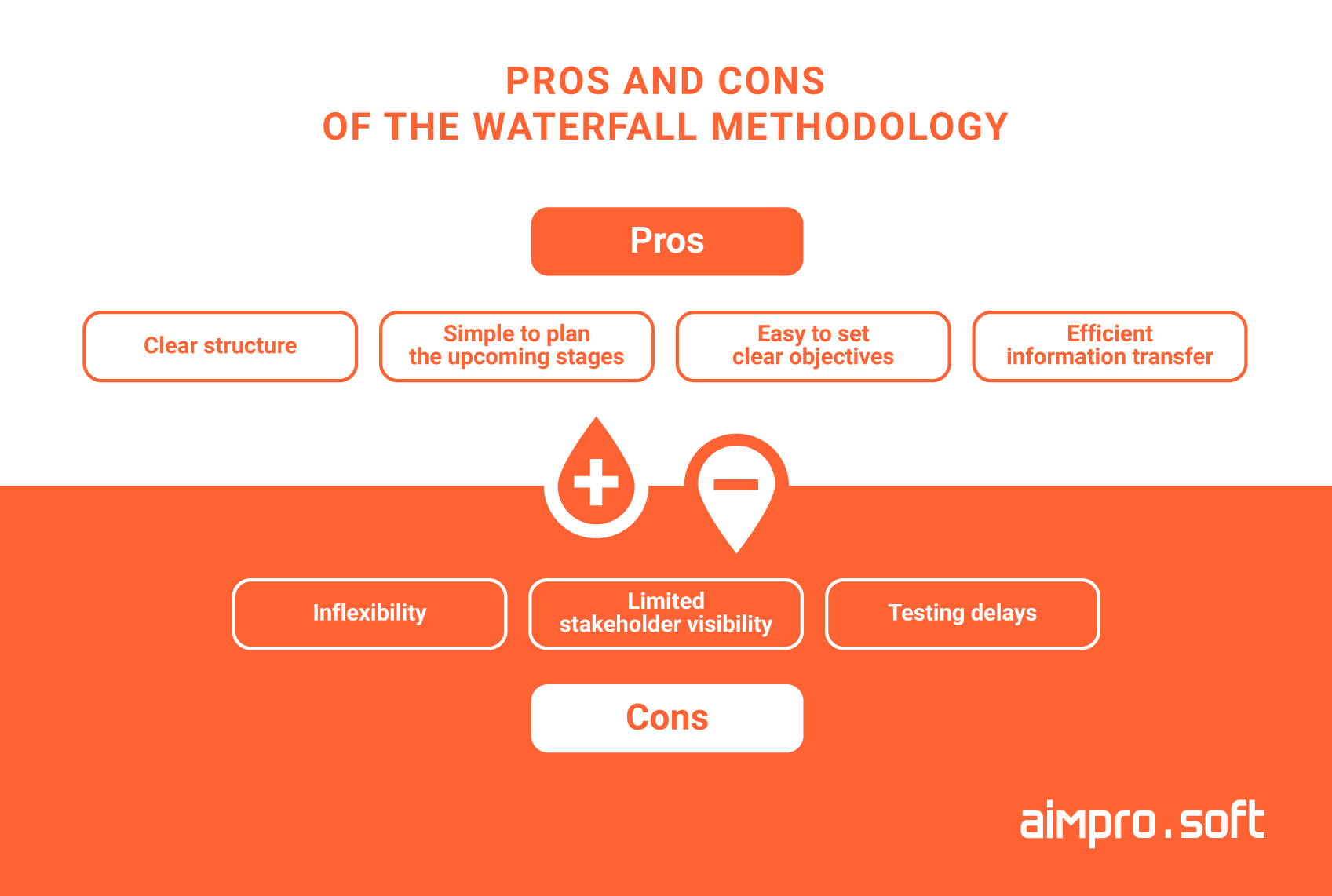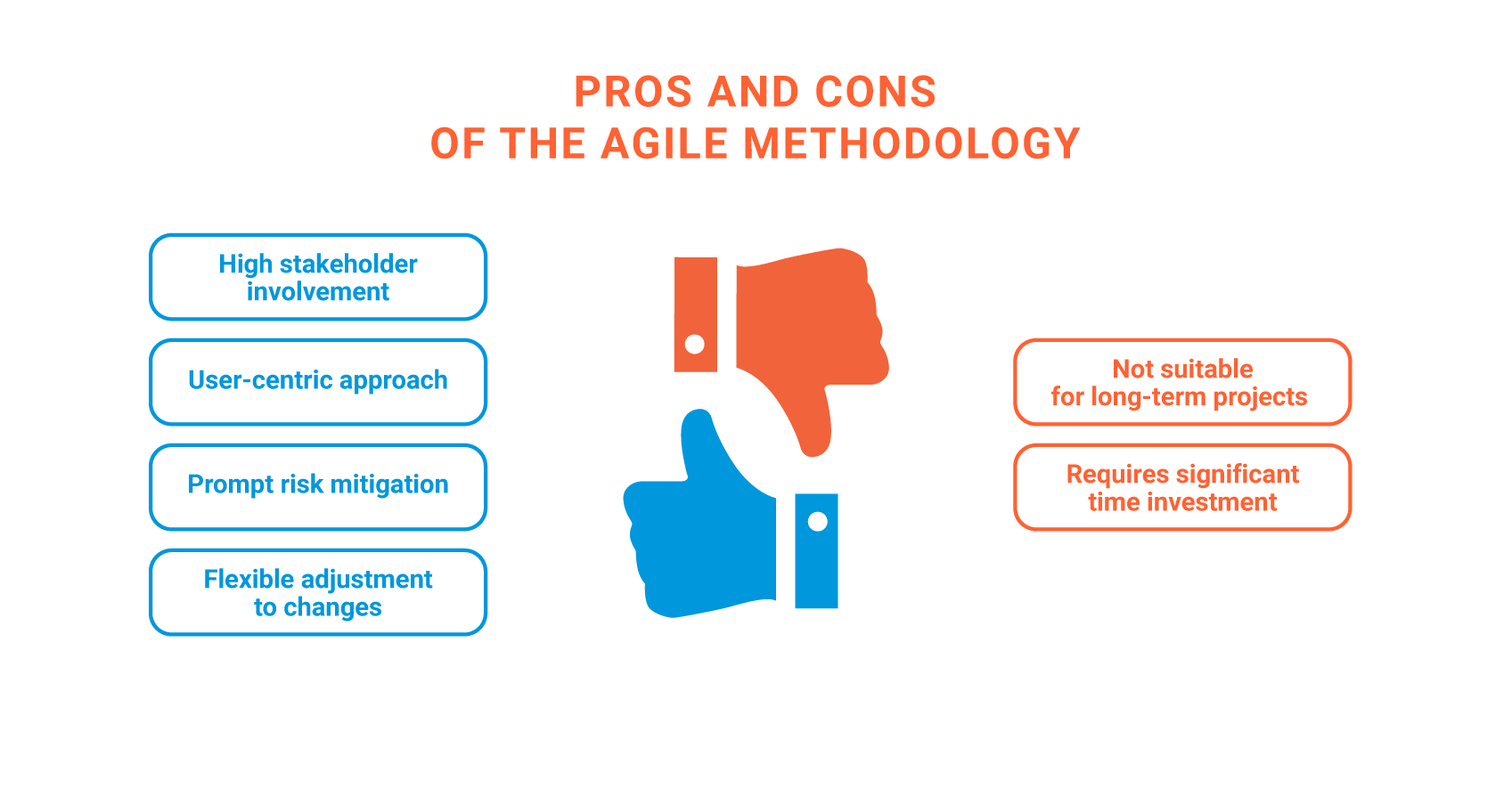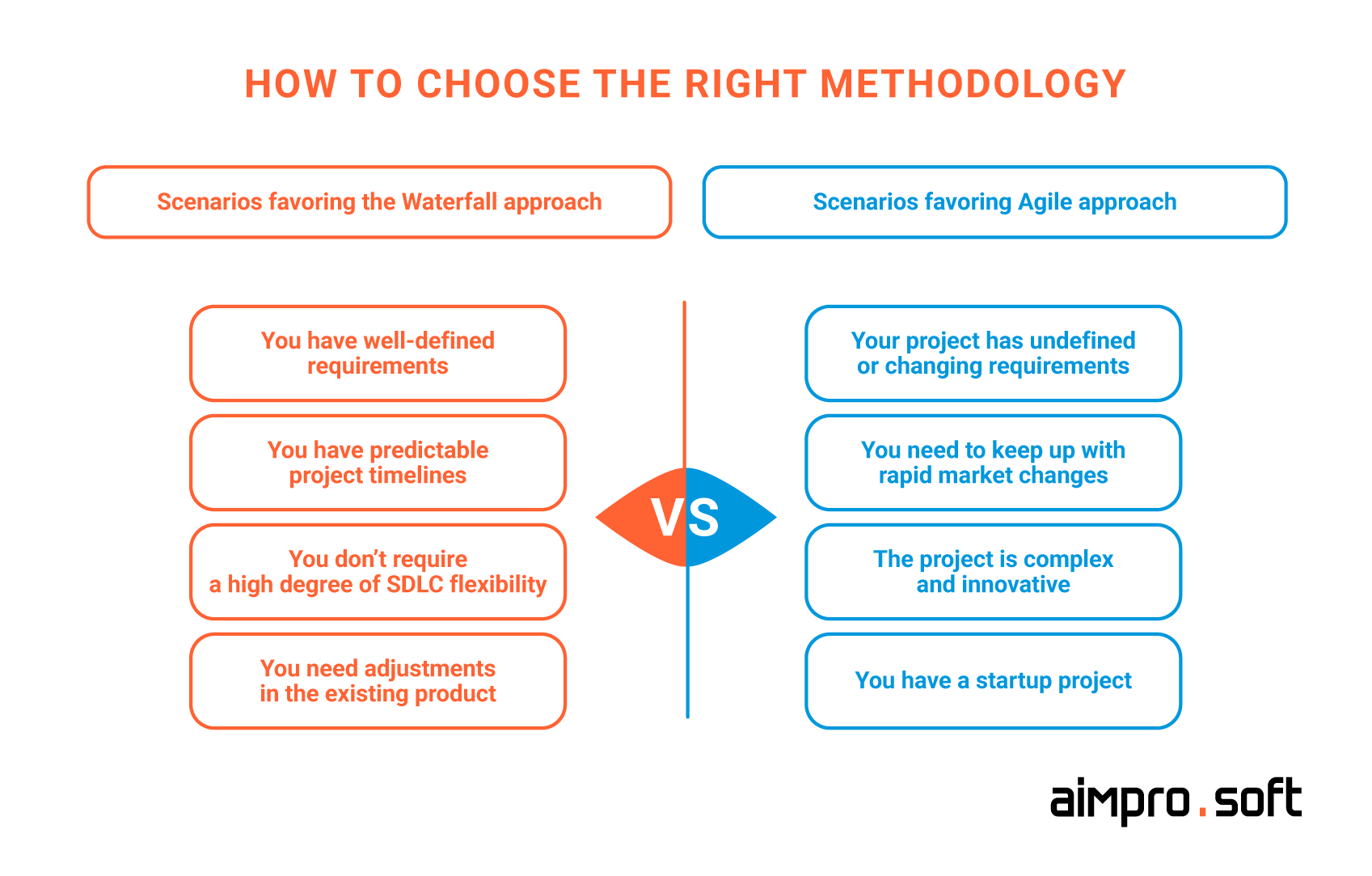Waterfall vs Agile: What to Know Before Choosing Your Development Method

Key takeaways
- Learn about the main principles of Waterfall vs Agile methodologies and their strengths and weaknesses.
- Get an overview of the key difference between Agile and Waterfall to understand better which methodology to choose for your project.
- Explore the advantages and disadvantages of these two methodologies together for a more informed choice.
- What might work better for your project? Find out when it makes sense to use Waterfall vs Agile methodology and discover a new option, like a hybrid methodology.
When embarking on developing software projects, one of the most crucial and, at the same time, challenging choices to make is to select a methodology for project management correctly. This choice affects such aspects as tech specialists’ understanding of the entire flow, milestones, and expected deliverables, timely product completion, risk management, correct allocation of resources, project flexibility and adaptability to changes, and much more. The decision on methodology is often torn between the structured methodology Waterfall and the dynamic approach called Agile. Which one to choose, and how to realize that the choice has been made correctly?
In this article, we want to share our expert opinion and shed light on which approach is right for you. We will reveal the benefits of harmonizing Agile vs Waterfall practices, look at the real-world use of a hybrid methodology, and understand how to make Agile and waterfall methodologies work smoothly. Join us in this exploration to find the best fit for you to maximize the efficiency and success of your project.
Understanding Waterfall methodology
The Waterfall methodology is a project management approach that emphasizes a linear progression from the beginning to the end of a project. In this model, the project is divided into distinct stages, and each stage must be completed before moving on to the next one. It follows a sequential and rigid process, where phases occur in a specific order, and each phase’s completion triggers the start of the next one. Stakeholder and business owner requirements are gathered at the project’s outset, forming the foundation for subsequent phases.

A few interesting facts and statistics about the Waterfall approach:
- Waterfall, being the oldest project management methodology, drew inspiration from industries like manufacturing and construction, where the luxury of iteration is not feasible. In such fields, revisiting to “enhance” the foundation is impractical once a bridge is constructed.
- The Waterfall methodology, documented in 1970 by Dr. Winston Royce, was the first publicized life cycle model for software development.
- Over time, the Waterfall methodology gained popularity, especially in industries like construction, manufacturing, aerospace, and government systems.
- According to the PMI study, 56 % of projects used the traditional Waterfall method.
- As per Statista research, 32% of respondents said they favor the Agile method for software development, whereas 10% said they use the Waterfall methodology.
- According to the survey, Waterfall-based projects have an average success rate of 47%.
Core principles of the Waterfall methodology
Waterfall methodology is a systematic and linear project management approach widely used in various industries. This method is characterized by being structured and disciplined, providing a clear framework for project development. Let’s examine the basic principles on which the Waterfall methodology is based.
- Consistent structure
Waterfall adheres to sequential development, where a project is divided into distinct phases, and each phase must be completed before moving on to the next one.
- Sequential phases
Each phase represents a specific phase of the project, and progression proceeds linearly in one direction.
- One-way Structure
The Waterfall methodology adheres to a strict one-way structure, meaning project activities proceed in a predetermined order without returning to previous phases.
- Limited client involvement
Project work begins only after the client’s requirements have been carefully defined. Initial discussions are held before the start of the project, and subsequent meetings are conducted during the final stages of the project.
- Strong documentation
Thorough documentation becomes paramount, from project timelines to the specific strategies for addressing client’s concerns. Given the limited interaction with business owners during the development process, it is critical to document every vital detail upfront.
Pros and cons of Waterfall

Pros and cons of Waterfall
Pros
- Clear structure
Waterfall establishes a distinct and well-defined framework, emphasizing the roles of project managers and dev teams throughout each stage. It necessitates teams to distinguish the responsibilities of each member before project execution. This explicit clarity proves crucial in the planning, implementation, and management of intricate projects. It ensures that every team member comprehends their role in each phase, fostering effective collaboration for the accurate execution of the project.
- Simple to plan the upcoming stages
Waterfall methodology boasts a transparent structure with precisely outlined objectives and deliverables for each stage in the project life cycle. Consequently, managing such projects is straightforward, given that each milestone must be accomplished before proceeding to the subsequent level. This facilitates seamless progress tracking, making it uncomplicated to detect bottlenecks or delays that may have arisen in any phase.
- Easy to set clear objectives
This approach is conducive for project managers who prefer early goal setting and maintaining those objectives throughout the project’s lifecycle. Typically, in the Waterfall approach, the collection of important information and documentation design begins at the start of the project to determine the project’s objectives. Establishing these goals at the outset ensures that everyone is aligned with the objectives, fostering a shared purpose during both the planning and execution phases of the project.
- Efficient information transfer
Within the Waterfall approach, each phase is marked by distinct deliverables, facilitating the seamless transfer of project information from one stage to the other. This structured progression ensures a smooth knowledge transfer among team members. Given that this knowledge is frequently documented, it enables other teams, such as maintenance or support, to effortlessly resume from where their predecessors concluded, should the necessity arise. The methodical nature of the Waterfall model supports an efficient exchange of information, enhancing collaboration and continuity across different project phases.
Cons
- Limited stakeholder visibility
In contrast to alternative project management approaches the Waterfall methodology does not give precedence to customer feedback during product development. Instead, it emphasizes fulfilling predetermined requirements established earlier in the project lifecycle. The challenge with this method is that requirements may evolve, particularly as users engage with the product and offer valuable feedback. This lack of prioritization for ongoing client or end-user input can potentially result in a misalignment with evolving expectations and needs.
- Testing delays
In the Waterfall methodology, testing is often postponed to the later stages of the SDLC. This practice poses a potential risk as the delayed testing means that project managers and teams must patiently await for identification of possible critical bugs. If fixes are deemed necessary, eliminating them can be time-consuming, causing delays in the overall project timeline.
- Inflexibility
The inherent inflexibility of the Waterfall methodology stands as a significant disadvantage, particularly in dynamic and ever-evolving projects. This rigid structure dictates a linear progression, where each phase must be completed before moving to the next one. While this ensures a systematic and organized workflow, it becomes a challenge when changes are required mid-project.
In dynamic projects, unforeseen circumstances, shifting priorities, or emerging opportunities often necessitate adjustments to the original plan. Unfortunately, the Waterfall model does not readily accommodate such modifications once a phase has commenced. This lack of adaptability can lead to several issues, including the potential divergence of project outcomes from evolving requirements.
As you can see, the Waterfall methodology is a structured and systematic approach to project management that clarifies setting objectives, defining roles, and communicating information. However, its inflexibility and potential delays in testing pose significant challenges, particularly in dynamic and evolving project scenarios. Recognizing the limitations of Waterfall, an alternative methodology such as Agile should be explored. Let’s now examine it so that you can get a better understanding of which method suits your requirements best.
Exploring Agile methodology
The Agile methodology is a dynamic and iterative approach to project management that prioritizes flexibility, collaboration, and continuous improvement. Agile breaks a project into smaller steps, allowing teams to adapt to changing requirements and deliver tangible results quickly. In the realm of Agile, fostering open communication, collaboration, adaptation, and trust is paramount among team members. While the project lead or product owner usually determines the priority of deliverables, the team assumes a leadership role in shaping how the work is executed.

Agile isn’t characterized by rigid procedures or strict, phased completion of SDLC steps. Instead, it represents a collection of methodologies united by a dedication to close feedback loops and ongoing improvement.
A few interesting facts and statistics about the Agile approach:
- The Agile methodology originated in the 1990s when software development practices were undergoing a significant transformation.
- Agile was formally launched in 2001 when 17 technologists drafted the Agile Manifesto, defining four major principles for agile project management.
- According to the State of Agile study, after implementing Agile, respondents reported improvements in areas such as the ability to manage changing priorities 71%, project visibility 66%, business and IT alignment, etc.
- In the software sector, the use of agile methodology increased in 2021, rising from 37% to 86% of teams.
- Agile-based projects have a success rate of up to 64%.
- 25% of teams that implement Agile are highly productive.
- The fact that only 9% of projects in Agile fail, so it is understandable why more and more companies are adopting this methodology.
Core principles of Agile methodology
Agile values direct attention to core priorities, emphasizing adaptability and customer focus. By prioritizing deadlines in the Agile methodology, teams can maximize the product’s value under resource and time constraints. The financial value of requirements and strategic importance play a crucial role in Agile prioritization. Let’s take a quick look at Agile’s core values and principles.
- People and their interactions come first
A critical aspect of Agile is recognizing when established processes hinder efficient collaboration, indicating a need for adjustment. Ultimately, the focus is on empowering people to solve problems collaboratively, ensuring that the emphasis on tools and procedures is sufficient for their ability to perform effectively.
- Welcome to flexible changes and shifting requirements
In Agile methodology, embracing change precedes rigid adherence to a pre-designed plan. The focus is on delivering results aligned with business objectives, even if this requires a complete overhaul of the original plan and products. Agile emphasizes the importance of meeting real needs rather than blindly following outdated plans.
- Continuous delivery of software parts
Instead of waiting for long development cycles to create the final product, Agile divides a project into manageable iterations or sprints. Each sprint results in a potentially finished part of the project, allowing stakeholders to deliver tangible, functional software regularly.
- Close cooperation between stakeholders and developers
Unlike traditional methods, where requirements are fixed upfront, Agile welcomes changing requirements even later in the development process. Regular communication and collaboration facilitate a shared understanding of project goals. Business stakeholders provide valuable insights into evolving needs, while developers offer technical expertise.
- Support and motivation of all parties involved
Creating a supportive environment involves providing the necessary resources, removing obstacles, and acknowledging the importance of work-life balance. Trust is fundamental, with Agile teams given autonomy to make decisions. Motivation is fueled by aligning individual goals with project objectives and celebrating achievements.
- Self-organized teams
The Agile methodology advocates self-organizing teams, embodying the principle that the best architecture, requirements, and designs are created by self-organizing teams instead of traditional hierarchical structures. Likewise, Agile advocates a flatter management style where decisions are made collaboratively by the team rather than by an individual manager or management team. This is consistent with that Agile values teams and collaboration above processes and tools, fostering a collaborative environment. In practice, self-organizing teams operate as autonomous groups within an organization, taking control and responsibility for their projects.
Pros and cons of Agile

Pros and cons of Agile methodology
Pros
- High client & stakeholder involvement
At the heart of Agile methodology lies a crucial principle — customer collaboration. This key element underscores the vital role customers play in the development process. The Agile approach ensures that clients are well-informed about project progress by fostering consistent and open communication between the development team and the customer. This collaborative synergy aims to enhance transparency and forge a unified effort that ultimately results in the delivery of a superior-quality product.
- User-centric approach
The methodology contains a practice such as a user story; it is a valuable tool used to articulate software features from the end user’s perspective and create a concise and understandable representation of requirements. This technique helps to visualize the product’s user, clarify their needs, and understand the reasons behind those needs. Adopting a user-centered approach in Agile, mainly through user stories, greatly enhances project success.
User stories provide an accurate understanding of user needs, which enables focused development and a continuous feedback loop. In essence, user-centricity in Agile, exemplified by user stories, becomes a key strategy for realizing successful projects by ensuring requirements accuracy, adaptability to change, and active stakeholder engagement.
- Prompt risk mitigation
One notable benefit of Agile methodology lies in its capacity to proactively prevent risks throughout the development process. Agile achieves this by implementing automated tests and ensuring continuous assessment of code changes and system functionality. By systematically running regression tests before initiating new tasks, Agile teams can promptly identify and address potential issues, enhancing the overall stability and efficiency of the software development lifecycle. This proactive approach minimizes the likelihood of escalating risks and contributes to a smoother and more reliable project delivery.
- Flexible adjustment to changes
A fundamental characteristic of Agile methodology is its profound adaptability to change, fostering a culture that embraces and even welcomes modifications to project requirements. This flexibility acknowledges the dynamic nature of project landscapes, understanding that requirements may evolve over time. Agile not only accommodates but actively encourages teams to respond swiftly and adapt seamlessly to these changes. This adaptability proves invaluable as it empowers teams to stay attuned to market dynamics, embrace emerging technologies, and cater to shifting customer needs.
Cons
- Not suitable for long-term projects
One prevalent issue in Agile methodology arises when attempting to implement it in projects for which it is unsuitable. Agile aligns well with software development with its iterative approach focused on smaller, incremental deliverables. However, this level of fragmentation may pose challenges in the context of long-term projects.
- Requires significant time investment
Another aspect to factor into the challenges of Agile is that it’s time-consuming. Incorporating daily standup meetings into team members’ schedules can disrupt their workflow. Furthermore, the Agile philosophy necessitates continuous collaboration among developers, testers, clients, and other project stakeholders. This heightened level of interaction can impose a notable strain on Agile team members and their time management skills.
Overall, Agile methodology is emerging as a beacon of innovation, fostering adaptability, customer collaboration, and incremental progress. However, like any expedition, it comes with challenges, including potential unsuitability for long-term endeavors and significant time investment.
Having examined the nature of the Waterfall model vs Agile methodologies, it’s time to compare them. Continue reading to learn about their strengths, weaknesses, and subtleties, and understand which approach will facilitate your project’s success.
Want to learn about another methodology for software projects? Read our article on the DevOps approach to find out all the benefits it can bring.
Key differences between Waterfall and Agile
Having examined these two methodologies, you can see that the emergence of the Agile methodology was a direct response to the inflexible nature of the Waterfall approach. As such, Agile versus Waterfall represents a much more adaptable approach to project management. In contrast, the Waterfall methodology is a linear form of project management, well suited to projects where the end result is clearly defined from the beginning of the project. The expectations and deliverables of the project at each stage are clearly defined, and their fulfillment is a prerequisite for moving on to the next stage.
We recommend studying the detailed comparison table to understand their distinctive features and determine which one is more suitable for your project.
| Parameter | Waterfall | Agile |
|---|---|---|
| Phases | Well-defined phases (Requirements, Design, Development, Testing, Deployment) | Flexible, with overlapping phases and continuous feedback |
| Flexibility | Limited flexibility; changes are difficult to implement once the project starts | Embraces changes even late in the development process |
| Customer involvement | Minimal customer involvement during development; feedback at the end | Continuous customer collaboration and feedback throughout |
| Risk management | Identified and addressed at the beginning of the project | Ongoing risk assessment and adaptation throughout the project |
| Testing | Testing occurs after the development phase | Continuous testing throughout the development cycle |
| Suitable for | Often preferred by large, structured organizations such as banks, governments, insurance companies, and large teams | Agile is generally preferred in dynamic environments, making it suitable for startups, small teams, SaaS product development, and smaller companies |
| Speed | Waterfall projects typically have longer timelines, as all requirements must be finalized before the commencement of development | Agile projects often exhibit a quicker delivery pace than waterfall projects, attributed to the iterative development cycles inherent in Agile methodologies |
| Success measurement | Success is often measured by meeting the initial project plan | Success is measured by delivering value to the customer |
Advantages and disadvantages: Agile vs Waterfall
As we examine the pros and cons of the Waterfall approach vs Agile, it becomes necessary not only to identify their individual strengths and weaknesses but also to make insightful comparisons between them. In this section, we will analyze the Agile and Waterfall methods to highlight their unique characteristics and explore how they address critical aspects of project development.
1. Flexibility
Agile (advantage): Offers high flexibility by accommodating changes throughout the project, fostering adaptability to evolving requirements.
Waterfall (disadvantage): Lacks flexibility, making it challenging to incorporate changes once the project has commenced.
2. Project planning
Agile (advantage): Involves iterative planning, allowing for dynamic adjustments based on short-term goals and continuous feedback.
Waterfall (advantage): Comprehensive planning at the outset provides a clear roadmap, minimizing uncertainties during development.
3. Customer involvement
Agile (advantage): Prioritizes continuous collaboration between developers and stakeholders, ensuring real-time feedback and customer satisfaction.
Waterfall (disadvantage): Involves minimal customer interaction until the final stages, potentially leading to misunderstandings or misalignments.
4. Development speed
Agile (advantage): Accelerates development through shorter cycles, delivering functional software in incremental stages.
Waterfall (disadvantage): The approach can cause longer development cycles, as each phase must be completed before moving on to the next.
5. Risk management
Agile (advantage): Mitigates risks through constant evaluation and adaptation, facilitating the early identification and resolution of issues.
Waterfall (disadvantage): Carries a higher risk than Agile, as any deviations from the original plan can have significant consequences.
6. Documentation
Agile (disadvantage): Prioritizes working software over comprehensive documentation, potentially leading to a lack of detailed project requirements.
Waterfall (advantage): Requires extensive documentation at each phase, ensuring a detailed plan is in place before development begins.
7. Team collaboration
Agile (advantage): Promotes collaboration and cross-functional teams, fostering a collective sense of ownership.
Waterfall (disadvantage): Can result in siloed teams working independently within their designated phases.
8. Time frame
Agile (advantage): Uses brief iterations to produce results rapidly, enabling teams to change their plans over time and meet deadlines earlier.
Waterfall (advantage): Each step of the project is dependent upon the one before it and is executed in a linear method.
As we may have realized after careful examination of the advantages and disadvantages of Agile and Waterfall methodologies, each approach has unique strengths and weaknesses. The choice between these methodologies is not a matter of a one-size-fits-all approach but rather a strategic decision influenced by project requirements, team characteristics, and organizational goals.
Agile’s iterative nature and flexibility favor a dynamic environment, facilitating adaptability and rapid response to change. However, this flexibility can create project documentation and stakeholder engagement challenges. On the other hand, Waterfall’s structured and consistent approach provides clarity and complete documentation from the outset. However, its rigidity can become a hindrance when faced with changing project scope and dynamic client needs.
But if each Agile method vs Waterfall has pros and cons, how do you choose one for your project? Well, let’s figure it out in our next section.
In addition to an overview of popular PM methodologies, you may want to get tips on managing remote teams. Read our article on the topic to look at all aspects of management.
Making the right choice
The choice between Waterfall and Agile methodologies plays quite an essential role in the success of software development. In this section, we will help you make the right choice. We will look at the factors that may lead you toward the structured Waterfall path and the scenarios where the dynamic flexibility of the Agile approach takes over.
Understanding the nuances of when to adopt the linear progression of Waterfall or opt for the flexibility of Agile is critical for project managers and stakeholders alike.

How to choose the right methodology for your project
Factors influencing Waterfall selection
So now we’re going to look at a few scenarios and circumstances that influence the choice of the Waterfall methodology for your project.
You have well-defined requirements
The waterfall methodology will come in handy when project requirements are carefully detailed and expected to remain unchanged throughout the development lifecycle. This structured approach is beneficial when the project team thoroughly understands the client’s needs, leaving little room for significant changes or iterations. This clarity and predictability are helpful when working with projects that require a precise roadmap from inception to delivery.
You have predictable project timelines
Waterfall is suitable for projects with strict deadlines and a well-defined endpoint. This is especially true when deadlines are non-negotiable, and deviations from the planned schedule can have significant consequences. The consistent nature of the Waterfall allows project managers to set clear milestones and deadlines from the outset. This feature makes Waterfall a suitable choice for projects in industries where time is critical and a structured approach is paramount.
You don’t require a high degree of SDLC flexibility
In industries with strict regulations and compliance standards, Waterfall’s emphasis on comprehensive documentation becomes a key advantage. Industries such as finance, healthcare, and aerospace, where compliance is non-negotiable, benefit from Waterfall’s thorough planning and documentation. The methodical nature of Waterfall is consistent with the need for extensive documentation to demonstrate regulatory compliance.
You need adjustments in the existing product
Although the Waterfall methodology is traditionally known for its consistent and inflexible structure, it has distinct advantages for completed projects that require modifications.
In scenarios where changes are predictable and can be planned, the rigidity of Waterfall becomes an advantage. Since the entire project is laid down from the beginning, making planned changes is consistent with the linear evolution of the methodology. Reduced risk of scope creep: the structured waterfall approach minimizes the risk of scope creep during the development phase. Changes made after development do not result in uncontrolled changes, ensuring a controlled and focused adjustment process.
Scenarios favoring Agile approach
Now, let’s look at the most common scenarios for choosing an Agile methodology.
Your project has undefined or changing requirements
Agile supports change through iterative development cycles. This flexibility allows teams to adapt to the evolving requirements effectively. The iterative nature of Agile allows for constant refinement of project requirements based on continuous feedback and changing business needs. This is why this approach is well suited to projects that anticipate changes during the development journey.
The project is complex and innovative
Agile is ideal for projects that require creative problem-solving, offering an environment conducive to experimentation and innovative thinking. This methodology allows teams to explore out-of-the-box solutions and dynamically adapt to creative challenges, fostering a culture of continuous innovation.
You need to keep up with rapid market changes
Agile methodologies give organizations seeking continuous innovation and product development a strategic advantage. The flexibility inherent in Agile allows teams to switch quickly, respond to market dynamics, and iteratively refine product features. This adaptability becomes crucial in an ever-changing landscape, ensuring that products meet market requirements and customer expectations.
You have a startup project
Agile is a lifeline for startups facing the need to create products or services with limited resources quickly. The methodology’s emphasis on iterative development and rapid prototyping fits perfectly with the startup ethos. It facilitates the quick release of minimum viable products (MVPs), allowing startups to gather valuable early user feedback, iterate features, and accelerate their growth trajectory.
Can Agile and Waterfall coexist?
The answer is clear and straightforward. Definitely, yes, these two methodologies can be combined on the same project, and what’s more, it can be rather beneficial. You can always take the strengths of the two methodologies and use them to the advantage of your project. In project management, the choice between Agile and Waterfall isn’t always exclusive. Many projects benefit from a blend of both methodologies.
Examale: Imagine a software development project for a startup. Initially, the team defines core functionalities and begins development using Waterfall for a structured foundation. Agile methodologies are introduced to adapt to changing market demands and user feedback as the project advances. This hybrid approach ensures a solid initial structure while allowing for flexible adjustments and rapid responses to evolving requirements.
Scenarios when you may need a hybrid approach?
- Project specifics
Depending on the nature and requirements of the project, some phases may be better suited to an iterative Agile approach. In contrast, others may benefit from a structured and consistent Waterfall process.
- Legacy systems
Where a project involves integrating existing systems or compliance with specific regulatory requirements, Waterfall may be chosen for some phases to ensure strict documentation and compliance.
- Transition periods
Organizations moving from Waterfall to Agile or vice versa can use a hybrid model to manage the transition smoothly during the adaptation period.
- Parallel development
On large projects, teams can simultaneously use Waterfall for the initial planning and design phases and apply Agile for development and testing. This provides a structured start and flexibility to adapt during application.
- Phase integration
Projects can be divided into separate phases, each managed using Agile or Waterfall, depending on the requirements. For example, Agile may be suitable for prototyping and iterative development, while Waterfall is used for refinement and documentation.
As you may have noticed, after we examine when to use Agile and when to use Waterfall, it is clear that the decision to choose one over the other is sometimes binary. A combination of Agile and Waterfall is a pragmatic approach, especially in projects requiring flexibility and structured planning. Ultimately, the key is to understand the unique requirements of each task. Whether it is the structured sequencing of Waterfall or the adaptive nature of Agile, the success of a project depends on matching the chosen methodology to the specific characteristics and goals of the project.
Contact us, and our project managers can find an approach that best suits the requirements of your project.
CONTACT USConclusion: striking the balance
The choice between Agile vs Waterfall methodologies is never an easy decision but rather a nuanced consideration of project characteristics, goals, and constraints. Each approach has its strengths and weaknesses. Waterfall’s structured and consistent approach is suited to well-defined projects with stable requirements, tight deadlines, and the need for strict compliance with the set requirements. On the other hand, Agile thrives in environments where requirements are most likely to change, you, as a client, want to be frequently involved, and projects are complex and large in scope. To determine the most appropriate approach, such factors as budget constraints, the degree of the desired project flexibility, and the team’s level of self-organization need to be precisely considered.
In some cases, a hybrid model combining Agile vs Waterfall elements can be a balanced solution. To find that right balance, you need to evaluate all of the factors we’ve listed above carefully. Ultimately, success lies in aligning the chosen methodology with the specific requirements and goals of the project, ensuring a harmonious and effective realization of your product. If you need help determining a methodology to realize your project, you can always turn to us for help. Aimprosoft has a large number of specialists on board who can work on the basis of any of these methodologies and assist you with building a product that matches your vision.
FAQ
Can Agile and Waterfall be combined in a single project?
You can combine Agile and Waterfall in one project by using a hybrid approach. This method involves integrating elements of both methodologies to utilize Waterfall’s structured planning and Agile’s adaptability. This allows for better project control while accommodating changes during development.
How does Agile handle changing project requirements?
Agile is excellent at handling changing project requirements through its iterative and incremental approach. It welcomes changes at any stage by facilitating continuous client collaboration, prompt feedback, and flexible adjustments. This adaptability ensures that the final product matches changing specifications, making Agile suitable for projects where requirements are subject to change.
When is Waterfall a better fit than Agile?
Waterfall is better suited than Agile for projects with well-defined, stable requirements, predictable timelines and where strict compliance to them is critical. It is suitable for situations where a comprehensive plan and documentation are needed from the start of the project. Large-scale projects with fixed scope and budgets often find Waterfall more appropriate, especially in regulated industries.











